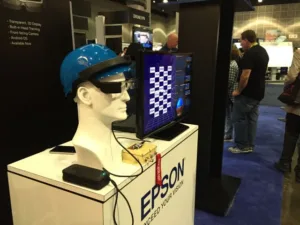Epson’s AR Glasses at Siggraph with integrated eye-tracking from SMI. Note the (rather) large brick required to process the data. It’s fine for industry but the company will have to migrate this to a much smaller package for commercial applicationsWe visited SensoMotion Instruments (SMI), a German company with a focus on providing its eye-tracking platform for mobile and wearable devices. The company offers reference design solutions for multiple platforms, including glasses for both AR and VR mobile devices, and even desktop and kiosk applications. Focus is on gaze tracking. The group claims the world’s first eye tracking integration for AR glasses. This was implemented in the Epson Moverio BT 200, which offers binocular transparent display, placed directly in the field of view of the user (augmented reality).
The SMI eye tracking technology means that developers can supply pop-up content on demand, based on where the user is looking. Software designers use this approach to trigger task-relevant information, in maintenance apps, for example. When working on a complex task, just the level of information needed can be cued up in the augmented environment to keep the user on task. Applications for the technology go well beyond the commercial space and are moving into the mainstream like gaming, consumer, retail, and more. SMI emphasised hands-free interaction as another big advantage of this approach, using ‘in-the-loop gaze guidance’, which can direct users to the next relevant task through integrating expert knowledge systems. Tracking and collecting the eye and gaze data is also used to document/archive events and tasks that can later be reviewed for accuracy (so careful, Big Brother is watching where you are watching!).
SMI booth at Siggraph shows off eye-tracking integrated on the Oculus Rift, note the software running on the laptop tracking the eyes
The SMI SDK for the Epson Moverio also supports gaze data, synchronised with the AR content in real-time. Specifications include 30Hz binocular tracking with on-display accuracy of < 0.6-degrees with data that includes pupil position, diameter, IP distance (inter-pupilary), inter-ocular distance, eyeball centre and distance to screen, plus point of regard on display and real-world (based on scene camera). SMI said that an upgrade package is also available for the Oculus Rift DK2. The company focuses on OEM solutions that range from the sciences (e.g. neuroscience and psychology) to consumer research, usability, VR, AR and CAVE systems. SMI was the only eye-tracking vendor we found at the show.

